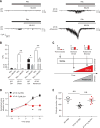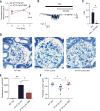A small-molecule inhibitor of TRPC5 ion channels suppresses progressive kidney disease in animal models
- PMID: 29217578
- PMCID: PMC6014699
- DOI: 10.1126/science.aal4178
A small-molecule inhibitor of TRPC5 ion channels suppresses progressive kidney disease in animal models
Abstract
Progressive kidney diseases are often associated with scarring of the kidney's filtration unit, a condition called focal segmental glomerulosclerosis (FSGS). This scarring is due to loss of podocytes, cells critical for glomerular filtration, and leads to proteinuria and kidney failure. Inherited forms of FSGS are caused by Rac1-activating mutations, and Rac1 induces TRPC5 ion channel activity and cytoskeletal remodeling in podocytes. Whether TRPC5 activity mediates FSGS onset and progression is unknown. We identified a small molecule, AC1903, that specifically blocks TRPC5 channel activity in glomeruli of proteinuric rats. Chronic administration of AC1903 suppressed severe proteinuria and prevented podocyte loss in a transgenic rat model of FSGS. AC1903 also provided therapeutic benefit in a rat model of hypertensive proteinuric kidney disease. These data indicate that TRPC5 activity drives disease and that TRPC5 inhibitors may be valuable for the treatment of progressive kidney diseases.
Copyright © 2017 The Authors, some rights reserved; exclusive licensee American Association for the Advancement of Science. No claim to original U.S. Government Works.
Figures




Comment in
-
TRP'ing up chronic kidney disease.Science. 2017 Dec 8;358(6368):1256-1257. doi: 10.1126/science.aar3572. Science. 2017. PMID: 29217557 No abstract available.
-
Stop TRPC5 in Kidney Disease: A Game Changer for Renal Allograft Protection?Transplantation. 2018 Jul;102(7):1027-1029. doi: 10.1097/TP.0000000000002209. Transplantation. 2018. PMID: 29952922 Free PMC article. No abstract available.
Similar articles
-
Renal physiology: TRPC5 inhibition to treat progressive kidney disease.Nat Rev Nephrol. 2018 Mar;14(3):145-146. doi: 10.1038/nrneph.2018.4. Epub 2018 Jan 22. Nat Rev Nephrol. 2018. PMID: 29355170 No abstract available.
-
Regulation of TRPC6 ion channels in podocytes - Implications for focal segmental glomerulosclerosis and acquired forms of proteinuric diseases.Acta Physiol Hung. 2015 Sep;102(3):241-51. doi: 10.1556/036.102.2015.3.2. Acta Physiol Hung. 2015. PMID: 26551740 Review.
-
Inhibition of the TRPC5 ion channel protects the kidney filter.J Clin Invest. 2013 Dec;123(12):5298-309. doi: 10.1172/JCI71165. Epub 2013 Nov 15. J Clin Invest. 2013. PMID: 24231357 Free PMC article.
-
The small GTPase regulatory protein Rac1 drives podocyte injury independent of cationic channel protein TRPC5.Kidney Int. 2023 Jun;103(6):1056-1062. doi: 10.1016/j.kint.2023.01.016. Epub 2023 Feb 5. Kidney Int. 2023. PMID: 36750145 Free PMC article.
-
Charting a TRP to Novel Therapeutic Destinations for Kidney Diseases.Trends Pharmacol Sci. 2019 Dec;40(12):911-918. doi: 10.1016/j.tips.2019.10.001. Epub 2019 Nov 5. Trends Pharmacol Sci. 2019. PMID: 31704171 Free PMC article. Review.
Cited by
-
Phenotypic variation in a neotropical understory bird driven by environmental change in an urbanizing Amazonian landscape.Oecologia. 2021 Jul;196(3):763-779. doi: 10.1007/s00442-021-04976-x. Epub 2021 Jul 14. Oecologia. 2021. PMID: 34259906
-
Abnormal Crosstalk between Endothelial Cells and Podocytes Mediates Tyrosine Kinase Inhibitor (TKI)-Induced Nephrotoxicity.Cells. 2021 Apr 12;10(4):869. doi: 10.3390/cells10040869. Cells. 2021. PMID: 33921219 Free PMC article. Review.
-
Six Decades of History of Hypertension Research at the University of Toledo: Highlighting Pioneering Contributions in Biochemistry, Genetics, and Host-Microbiota Interactions.Curr Hypertens Rep. 2022 Dec;24(12):669-685. doi: 10.1007/s11906-022-01226-0. Epub 2022 Oct 27. Curr Hypertens Rep. 2022. PMID: 36301488 Free PMC article. Review.
-
Inhibition of Endocytosis of Clathrin-Mediated Angiotensin II Receptor Type 1 in Podocytes Augments Glomerular Injury.J Am Soc Nephrol. 2019 Dec;30(12):2307-2320. doi: 10.1681/ASN.2019010053. Epub 2019 Sep 11. J Am Soc Nephrol. 2019. PMID: 31511362 Free PMC article.
-
Mechanisms underlying modulation of podocyte TRPC6 channels by suPAR: Role of NADPH oxidases and Src family tyrosine kinases.Biochim Biophys Acta Mol Basis Dis. 2018 Oct;1864(10):3527-3536. doi: 10.1016/j.bbadis.2018.08.007. Epub 2018 Aug 8. Biochim Biophys Acta Mol Basis Dis. 2018. PMID: 30293571 Free PMC article.
References
Publication types
MeSH terms
Substances
Grants and funding
LinkOut - more resources
Full Text Sources
Other Literature Sources
Molecular Biology Databases
Research Materials

